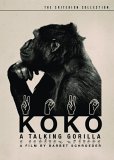| Reviews & Columns |
|
Reviews DVD TV on DVD Blu-ray 4K UHD International DVDs In Theaters Reviews by Studio Video Games Features Collector Series DVDs Easter Egg Database Interviews DVD Talk Radio Feature Articles Columns Anime Talk DVD Savant Horror DVDs The M.O.D. Squad Art House HD Talk Silent DVD
|
DVD Talk Forum |
|
|
| Resources |
|
DVD Price Search Customer Service #'s RCE Info Links |
|
Columns
|
|
|
Koko, a Talking Gorilla: The Criterion Collection
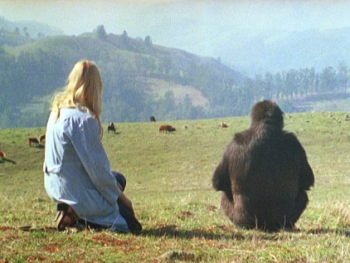
Regardless of expression or intent, humans communicate with other animals in many of the same ways they communicate with us and each other. Dogs, cats, and most other house pets can make it painfully obvious whenever they're ready for dinner, a walk, or a round of Frisbee in the backyard. It's amazing that communication isn't just limited to speech patterns, body language and the like, but many "higher" forms of interaction are what separate us from other forms of life. Until Fido really learns to speak, society will only think of him as the family dog.
This barrier between man and beast will always exist, but gray areas like those found in Barbet Schroeder's Koko, a Talking Gorilla (1978) will keep the animal rights debate burning for a long, long time. Koko, the primate in question, was a resident of the San Francisco Zoo transferred to Stanford University for a controversial experiment: she was taught sign language, accompanied by speaking, eventually learning to perform limited requests when prompted.
Koko's primary "trainer" was Penny Patterson (below left, just 27 at the time of filming), who would reward her after a successful request was met---in the same way that some might teach, say, an autistic child. Naturally, many of the study's detractors have cited these "rewards" as an empty training method, insisting that Koko was simply responding to commands she didn't truly understand. Additionally, some argued that the gorilla's quasi-human treatment was inappropriate for a wild animal, hinting that Koko should be left either in the zoo or her natural habitat. A Talking Gorilla captures our subject during her earlier stages of development, immediately following her transition from one set of walls to another. With a life span of approximately 50 years, the six-year old Koko was still learning the basics of sign language and adapting to life in a more modern environment. All things considered, she passed with flying colors.

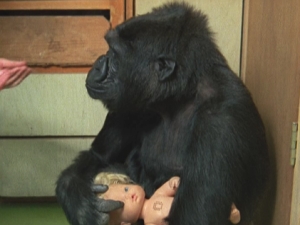
Though the footage itself is entertaining and eye-opening---though not to the extent it would've been some thirty years ago---the main flaw of Koko, a Talking Gorilla is its tendency to present such amazing footage in a painfully by-the-numbers style. We only get a glimpse of Koko and Penny's background, so the remaining footage represents just one stage of development; essentially, it's a sketch instead of a portrait. Luckily, plenty of more recent updates can be found in a multitude of media, but the film as a stand-alone effort rarely reaches above a standard level. Schroeder's film certainly provides us with an interesting subject and raises plenty of questions about the theory of evolution and mankind's relationship to other animals, but it doesn't dig deep enough to be completely satisfying.
Unfortunately, Criterion's thin treatment of Koko merely glosses over this flaw instead of strengthening its scope. A broad assortment of newer footage would have really put the film in a more fitting context, keeping the film and its questions more relevant in the process. While it's probably never looked or sounded better than it does on DVD, the technical presentation is a few steps away from perfect as well. It's hardly Criterion's best effort, but it's still a notable release that documentary fans should see at least once. Let's see how this disc stacks up, shall we?
Presented in its original 1.33:1 aspect ratio, Koko looks good but not excellent. The source material seems to be in slightly rough shape, as evidenced by the washed-out color palette, soft image and a few vertical scratches. Since most of these problems likely can't be corrected, a certain amount of leniency should be given. Unfortunately, the image also displays combing during scenes of fast motion, resulting in a flawed and mildly disappointing presentation...if only due to Criterion's excellent track record, of course.
The Dolby Digital Mono mix, presented in its original English or with a French dub of the narration, offers clean, clear dialogue and sound effects. Optional English and French captions are provided for the main feature only.
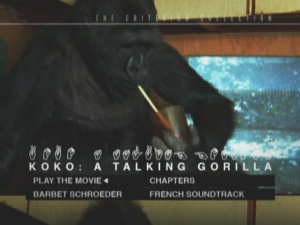
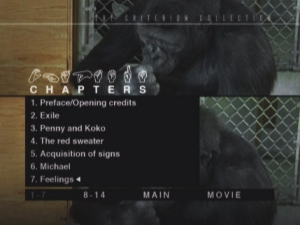
Also included is a pair of Text Essays in the booklet, penned by film critic Gary Indiana and author Marguerite Duras. While it's nice to get a few scraps, such lightweight treatment really lessens the impact of an otherwise interesting film. Even if it meant a higher price point, more substantial extras would've rounded the package out quite nicely.
It's a perfectly good time capsule for first-time viewers, but long-time fans of the documentary genre may find themselves a bit disappointed with Koko, a Talking Gorilla---not due to the footage itself, but the rather straightforward way that it's been presented. Still, the film's clear argument in favor of evolution raises its own set of interesting questions, enough to make it worthwhile viewing for animal lovers and young educators alike. Sadly, the film's weaknesses are even more evident on Criterion's single-disc treatment: with an adequate but flawed technical presentation and a sparse selection of extras, Koko plays more like a dated curiosity than a relevant case for animal rights. Fans of the film will be happy to finally have Koko on DVD, but most everyone else should be content with a one-time viewing. Rent It.
Randy Miller III is an affable office monkey based in Harrisburg, PA. He also does freelance graphic design projects and works in a local gallery. When he's not doing that, he enjoys slacking off, general debauchery, and writing things in third person.
|
| Popular Reviews |
| Sponsored Links |
|
|
| Sponsored Links |
|
|
| Release List | Reviews | Shop | Newsletter | Forum | DVD Giveaways | Blu-Ray | Advertise |
|
Copyright 2024 DVDTalk.com All Rights Reserved. Legal Info, Privacy Policy, Terms of Use,
Manage Preferences,
Your Privacy Choices | |||||||









